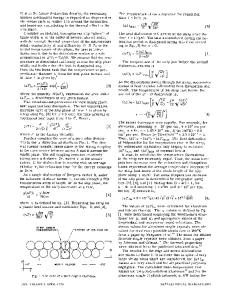The Effect of Constraints on Plastic Deformation
- PDF / 63,985 Bytes
- 6 Pages / 612 x 792 pts (letter) Page_size
- 19 Downloads / 532 Views
0980-II02-05
The Effect of Constraints on Plastic Deformation Vaclav Paidar Dept. of Metals, Institute of Physics, Na Slovance 2, Prague, 182 21, Czech Republic
ABSTRACT The effect of the deformation constraints is examined for the lamellar structure of TiAl where the unconstrained plastic deformation occurs parallel to the lamellae. The constraints generally redistribute the stresses in such a way that the resolved shear stresses are decreased on the most stressed systems and increased on other systems. This behaviour leads to the material strengthening and may enhance the ductility when more deformation modes are activated. INTRODUCTION Lamellar interfaces are not only efficient obstacles for propagating plastic deformation they can also enhance material ductility. When the plastic flow is forced to propagate parallel to the lamellae it can encounter a differently oriented lamellar system that can obstruct this flow. Hence it is important to investigate what is the influence of deformation constraints as it is done in this paper. Lamellar structures can be observed in various materials where they are formed to minimize the total elastic energy, for example, in systems with several structural variants, in particular, in structures arising during displacive phase transformations [1,2]. The occurrence of interfaces can activate new deformation modes, increase material strength but can also enhance its ductility. As an example of lamellar structures so called polysynthetically twinned (PST) crystals of TiAl [3] were chosen. Their microstructure has a beneficial effect on mechanical properties and deserve so a special attention. It has been shown that PST crystals composed of series of parallel lamellae deform more easily along the lamellae even when the applied shear stress on the planes parallel to the lamellae is zero [4-8]. However, in polycrystalline materials such deformation is restricted by the surrounding grains that prevent the strain to propagate freely in desired directions. In this paper we discuss the straining of lamellar structure of a single PST crystal. The loading axis is parallel to the lamellae and the plastic deformation can propagate freely along the lamellae only in an unconstrained state. The resolved shear stresses acting on all distinct slip and twinning planes are compared with the constrained state where the deformation is blocked in the direction parallel to the lamellae and perpendicular to the loading axis. The calculations based on the anisotropic elasticity for this relatively simple geometry represent a model case for general polycrystalline materials where the constraints are imposed by the surrounding grains. The results of calculations can be verified by the observations of active deformation modes in the samples deformed without and under constraints.
MODEL Six variants of the γ-phase of TiAl differing in the orientation of the tetragonal axis can be distinguished [9]. Three of them are associated with three cubic axes, multiplied by two due to two different stacking of atomic
Data Loading...











